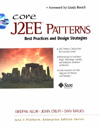| Presentation Tier |
| Business/Integration Tier |

| Core J2EE
Pattern Catalog
|
|
Bad practices are less than optimal solutions that conflict with many
of the patterns' recommendations. When we documented the patterns and
best practices, we naturally discarded those practices that were less
than optimal.
In each section, we briefly describe the bad practice and provide numerous
references to design issues, refactorings, and patterns that provide further
information and preferable alternatives. We do not provide an in-depth
discussion of each bad practice, but rather present a brief synopsis as
a starting point for further investigation.
The "Problem Summary" section provides a quick description of a less
than optimal situation, while the "Solution Reference" section includes
references to:
- Patterns that provide information on context and trade-offs;
- Design considerations that provide related details;
- Refactorings that describe the journey from the less than
optimal situation (bad practice) to a more optimal one, a best practice,
or pattern.
The Core J2EE Patterns book discusses various bad practices for the J2EE
Platform. Currently, these are not available on this website. The bad
practices listed on this page are described in detail in the Core
J2EE Patterns book.
The following bad practices are presented in detail in the Core
J2EE Patterns book.
- Control Code in Multiple Views
- Exposing Presentation-Tier Data Structures to Business Tier
- Exposing Presentation-Tier Data Structures to Domain Objects
- Allowing Duplicate Form Submissions
- Exposing Sensitive Resources to Direct Client Access
- Assuming <jsp:setProperty> Will Reset Bean Properties
- Creating Fat Controllers
- Mapping Object Model directly to Entity Bean Model
- Mapping Relational Model directly to Entity Bean Model
- Mapping each Use Case to a Session Bean
- Exposing All Enterprise Bean Attributes via Getter/Setter Methods
- Embedding Service Lookup in Clients
- Using Entity Bean as Read-Only Object
- Using Entity Beans as Fine-Grained Objects
- Storing Entire Entity Bean-Dependent Object Graph
- Exposing EJB-related Exceptions to Non-EJB Clients
- Using Entity Bean Finder Methods to Return a Large Results Set
- Client Aggregates Data from Business Components
- Using Enterprise Beans for Long-Lived Transactions
- Stateless Session Bean Reconstructs Conversational State for Each
Invocation
|


